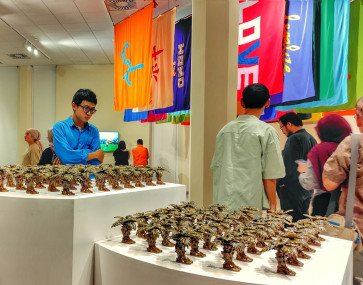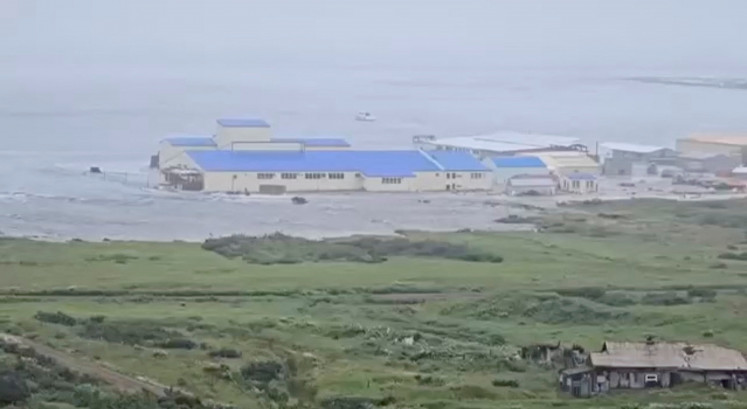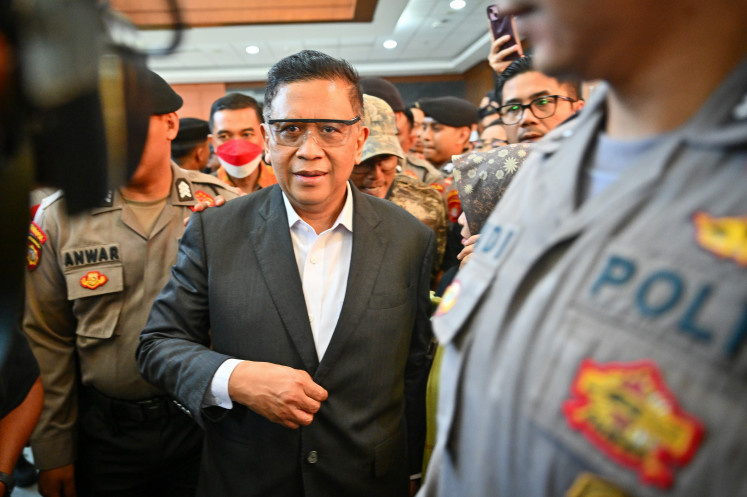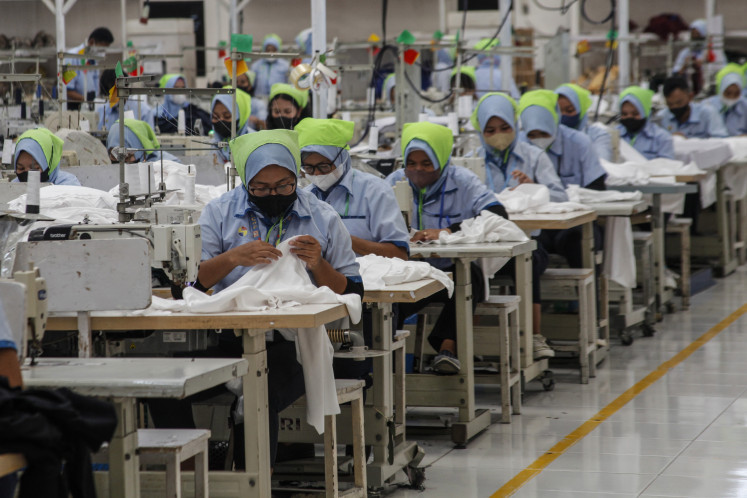Popular Reads
Top Results
Can't find what you're looking for?
View all search resultsPopular Reads
Top Results
Can't find what you're looking for?
View all search resultsProper system needed for sporting success: KOI official
To be the best: A young Indonesian weightlifter practices at a training center in Bekasi, West Java
Change text size
Gift Premium Articles
to Anyone
T
span class="caption" style="width: 398px;">To be the best: A young Indonesian weightlifter practices at a training center in Bekasi, West Java. Weightlifting and badminton are two sports in which Indonesia usually excels at the Olympics. However, in weightlifting, lack of funding is a big problem. JP/R. Berto WedhatamaThe sum of A$20,000 was offered to any Australian athlete who brought home a gold medal from the 2008 Beijing Olympic Games. One billion rupiah (A$ 105,000) was on offer for any Indonesian who achieved the same feat.
The prize money for Indonesian athletes was roughly five times that for their Australian counterparts. However, the figure was even more significant given Indonesia’s gross domestic income (GDI) per capita of US$4,200, whereas Australia’s was US$41,000.
Rita Subowo, president of the Indonesian Olympic Committee (KOI) and an International Olympic Committe (IOC) member, believes that if Indonesia can be a world leader in economics, there is no reason why it also can’t be a world leader in sport.
“Because we are in the G20 we have to be at the top level, at least in the top 30 places [of sporting countries],” she recently told The Jakarta Post.
Greg Wilson, former Australian World Championship medalist in power lifting, who is now the project manager for KOI, agrees.
“There is a lot of money,” he says. “It’s not a poor country and that kind of mentality needs to be changed. A lot of people who grew up here 50 and 60 years ago still see Indonesia as this kind of poor country, whereas I come here and you can see it really developing.”
Australia sent 435 athletes to Beijing, who brought home 46 medals, 14 of them gold. Indonesia sent 24, returning with one gold from five medals.
So then if it’s not money, what is it? How can a country with a US $1.03 trillion gross domestic product (GDP) be flailing on the international sporting scene? If it’s not the amount of money, then it must be how that money is spent.
Sabihisma Arsyi, 25, and Tri Eka Sandiri, 23, are elite synchronized swimmers who have represented their province and country at several National Sports Games (PON) and SEA Games. Last year they also competed at the 2011 FINA Swimming World Championships in Shanghai. When asked if they dreamt of going to the Olympics, both girls enthusiastically said yes, but they added that it was very hard for Indonesians to do so, because of having to compete with countries that had higher standards in the sport, such as China and Japan.
It’s questionable as to why this excuse is constantly used in Indonesian sport. China has obviously invested money in its sporting industry in a different manner in order to achieve higher standards. As Wilson suggests, perhaps the incentive to perform well in regional competitions in non-Olympic disciplines would not be so high if Indonesia’s sporting goal was to be among the top 30-ranked Olympic nations.
“You should see the gym where I train athletes. It’s not international standard level. You’ve got stuff in there that’s 40 and 50 years old and we’ve got national-level athletes that we’re trying to get through,” said Wilson, who also trains a number of Indonesian athletes in a variety of sports for international selection.
In Australia it is a compulsory part of primary school physical education for children to have swimming lessons. Wilson admits that it is generally taken for granted that there will be a pool five minutes down the road.
“There are probably more Australians who know how to swim than Indonesians, because of the fact that they have more swimming pools,” despite the vast difference in population, Wilson said.
Indonesian national diving coach Harli Ramayani agrees that Indonesia needs more sporting facilities. With diving being an up-and-coming event on the Indonesian sporting scene, Harli said that it was particularly difficult to come across facilities to train her athletes. But when asked whether she thought athlete bonuses were a good thing, Harli replied, “Yes, but I think more facilities are also important.”
Having state of the art facilities is one thing, but unless ongoing maintenance costs are factored into the budget, derelict buildings and green swimming pools will become more common, just as, Wilson explains, we can now see after the 2008 PON in East Kalimantan.
“My feeling is that most of these things are under-budgeted,” Wilson explains. “When planning a large sporting event in Indonesia, such as last year’s SEA Games, generally the money not budgeted for in the beginning is brought together hurriedly under a crisis management plan, with a lack of a maintenance after the event.
“For any structure, you usually have a 50-year plan and what you find is you need to budget around 2.5 to 3 percent per year afterwards to maintain it, which is a lot of money if the infrastructure costs 100 million, [so that is often] not a part of the equation.”
Indonesia is not alone here, with Wilson referring to the aftermath of the Delhi Commonwealth Games.
“There was a trillion US dollars spent on that, and now it’s not been used and has turned into a junkyard, whereas if you look at the Olympics in Australia and you go to the Sydney Olympic Center, that facility is like brand new. It was originally constructed in 1992, ready for the Olympics in 2000 and here we are 20 years later and you would think it had just opened.”
However, there is little point in making comparisons between the Australian and Indonesian sporting industries unless you are going to do something to change it.
Wilson cites sports management as the fundamental area to be improved in the Indonesian sports industry.
“There is no sports management system,” says Wilson, adding that Australia used to have a similar problem in the 1960s when a volunteer mentality prevailed.
“We never used to pay people to be coaches. They would just go along to help out. But in Australia now, at the intermediate and top levels, coaches and sports managers are paid good money and are expected to produce good results. Here it’s still on a volunteer basis, and that kind of volunteer mentality is not going to produce world-class
results.”
With such a volunteer-mentality likely comes little expectation.
But the question remains: does it really matter whether Indonesia is successful in the eyes of the sporting world? Ultimately, the answer is yes, as there is a link between sport and peace.
“I think humans are naturally competitive,” Wilson says. “If we didn’t have sport there would be more war. It provides a safe opportunity for the human species to interact in a way that is going to be compatible with their natural instincts. Its a healthy thing for us to be investing time and energy in. Otherwise, I think there would be many more problems in the world.”










